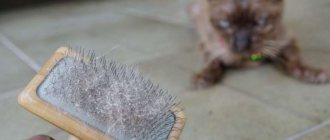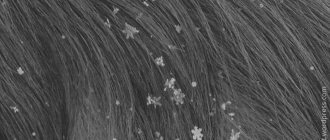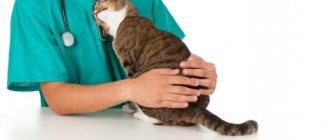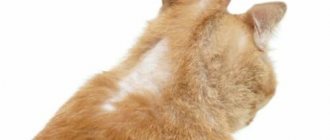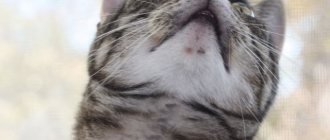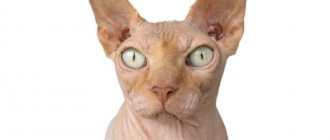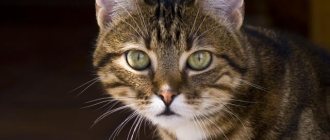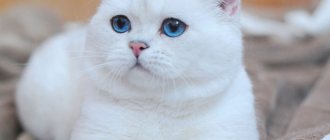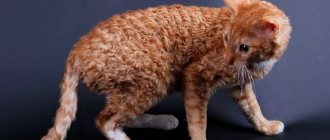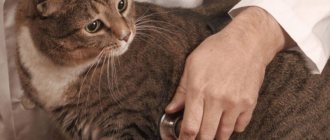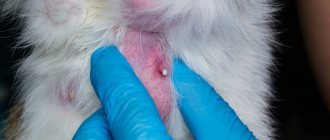The process of peeling off the top layer of keratinized skin occurs constantly, due to the renewal of the epidermis. Excessive accumulation of “scales” on the skin of an animal is called dandruff. Dandruff is a symptom of a pathological condition caused by disruption of the sebaceous glands and characterized by an increase in the rate of detachment of skin particles in the form of scales over a long period of time. The scientific name of this disease is seborrhea. It affects kittens and adult cats of all breeds, regardless of gender.
In the article we will tell you why dandruff appears, what to do when it is detected, how to cure seborrhea by going to the doctor and at home, as well as possible complications of the disease and preventive measures.
Main features
Signs of seborrhea in a cat:
- excessively oily skin under the coat;
- excessive amount of white “scales” of keratinized skin;
- inflammation (redness) of the skin;
- presence of itching.
There are three types of seborrhea:
- dry: “scales” of skin fall off when stroking the fur;
- oily: dandruff does not fall off when combed, the “scales” are glued together;
- mixed type.
Varieties
Dandruff can be oily or dry, depending on the cause of its appearance. Dry dandruff consists of white scales that cover almost the entire fur. If you pet your pet, the scales will fall off.
Oily dandruff has a watery structure that sticks the fur together. The wool seems to be covered with fat, it is sticky and unpleasant to the touch. Bathing has an effect for only 2-3 days, after which the coat becomes oily again.
If dandruff is thick, it is quite difficult to notice. During the process of combing the fur, oil and skin particles accumulate under the nails and on the comb. This dandruff can take the form of fairly large flakes.In the photo of dandruff in cats you can clearly see its appearance. If such phenomena are detected in a pet, the necessary measures should be taken, since this causes him significant discomfort.
Causes of dandruff
There are external and internal causes of the disease.
External ones include:
- Low level of air humidity. Dry air negatively affects the skin of the animal, the skin becomes thick and dry, and dandruff appears. Often accompanied by the appearance of cracks on the paw pads.
- Lack of proper care for the cat's fur and its place of residence, unsanitary conditions. In this regard, fleas, lice and other parasites appear and actively reproduce, causing irritation and itching of the skin. Dandruff can be caused by mites if the animal walks outside.
- The effects of cosmetics and cleaning products on animal fur.
Important! Using shampoo intended for humans may cause allergic reactions on your pet's skin.
- Improper combing of fur. Leads to irritation, scratches and microtraumas of the animal’s skin, which leads to accelerated skin regeneration and the appearance of “scales”.
- Sunburn or excess ultraviolet rays. They lead to accelerated death of epidermal cells and, accordingly, the appearance of dandruff.
- Stressful situations. For example: sterilization, moving to a new place, bringing another pet or child into the house.
- Frequent contact with water. Constant wetting of the skin causes irritation and drying out of the upper layer of the epidermis.
Internal factors:
- Incorrectly formulated diet. It entails a lot of health problems, such as:
- Obesity. If an animal is overweight, it is difficult to care for itself, reaching the back and lumbar area, which is why excess dandruff accumulates in these places.
- Allergic reactions.
Carefully! Allergies can be caused not only by food, but also by chemicals in finished food.
- Problems with the digestive system. They lead to metabolic disorders in the body, which affects the appearance of the cat.
- Vitamin deficiency or excess vitamins. For example, when there is a lack of vitamins A and B in the body, or when there is an excess of them, seborrhea appears.
- Bacterial or fungal diseases. For example, microsporia or lichen lead to skin irritation, constant itching and hair loss in the affected areas.
- Hormonal disorders (hypothyroidism, sex hormone imbalance, Cushing's syndrome). Disturbed metabolism associated with the functioning of the thyroid gland leads to seborrhea.
- Diseases of the musculoskeletal system (arthritis, arthrosis). Pain in the joints when moving prevents the cat from grooming the rump and tail areas, which leads to excessive deposits of “scales” on the skin in these areas.
- Diabetes. A disease associated with insufficient production of the hormone insulin and leading to metabolic disorders, which also affects the animal’s skin.
- Diseases of the urinary system.
- Seborrhea of idiopathic form. This is a hereditary disease characterized by the active secretion of sebum.
- Side effect from drug treatment. Skin reactions occur to medicated shampoo or to taking medications.
Additional symptoms
If your cat has dandruff, it is impossible not to notice it. A whitish coating is visible on the animal’s fur, especially in areas with abundant sebaceous glands: the back, ears, and the beginning of the tail. The disease is accompanied by itching, the cat scratches heavily behind the ears, the fur comes out in pieces, and white flakes remain on the litter.
Seborrhea begins with a change in the condition of the skin: it becomes oilier or, conversely, drier. Foci of inflammation appear. The listed symptoms are a reason to contact a veterinary center.
Types of dandruff
Dandruff is distinguished by color and location:
- By color:
- Yellow-white (grains or flakes) is localized on the back and other areas due to allergies, sunburn or malfunction of internal organs.
Black impurities in dandruff
- Black flecks in the fur along with dandruff can be a sign of fungal infections or the presence of parasites.
- By localization:
- On the back, in the area of the tail and lower back, symptoms of seborrhea most often appear due to fungal diseases (for example, microsporia, dermatomycosis), worms, sunburn, or due to the animal being overweight. Diseases of the musculoskeletal system can also affect this, preventing the cat from fully carrying out independent hygiene procedures.
- The “wandering” nature of seborrhea indicates the presence of parasites in the body, for example, subcutaneous mites. It may also be accompanied by baldness in certain areas of the skin, which is one of the symptoms of lichen or adenitis.
Preventive measures
To prevent the appearance of dandruff, the following measures should be taken:
- regular hygiene procedures. The coat should be brushed and combed every day;
- ensuring comfortable environmental conditions. The cat should not be constantly exposed to hot conditions;
- use of specialized shampoos;
- use of anti-parasite agents;
- balanced diet;
- ensuring a normal level of humidity in the room.
How to prevent seborrhea
Try to help your pet get rid of the disease yourself using the following methods:
- carry out antiparasitic treatment at home;
- check the air humidity level, you may need a humidifier;
Bathing a cat to treat dandruff
- examine the animal’s fur for the presence of fleas and ticks, if necessary, use a special shampoo or spray to get rid of them;
- study the composition of your cat’s diet for foods that can cause allergies or digestive problems;
- evaluate the appearance of the animal, it may be obese, and it is necessary to adjust the diet and diet;
- do not wash your pet more than once every 2 months; when washing, use only shampoo intended for this purpose and not too hot water;
- check the composition of household chemicals used when cleaning the house; you may have to change the products to less allergenic ones.
Important! If after carrying out all the above measures the disease progresses, contact your veterinarian.
Prepare in advance the answers to the questions that the doctor will ask you at the appointment to make the correct diagnosis. List of sample questions:
- What is the cat’s diet (main products, diet, amount of food).
- Basic habits and behavioral characteristics of the pet (for example, does it like to lie in the sun, which can cause sunburn).
- How well are hygiene rules observed at home?
- What products and how often do you use when bathing your pet and cleaning the house?
- What vitamin supplements do you give?
- Where and in what conditions does the cat live?
- What was or is you sick with? What medications were used for treatment.
- How do you care for your fur?
After collecting anamnesis, the doctor will prescribe the following tests:
- general blood test and biochemistry;
- blood test for hormones;
- skin scraping;
- inoculation on a nutrient medium and identification of skin culture;
- skin biopsy.
Dandruff on a cat's back near the tail
Such a phenomenon as bran from dead skin on the body of a pet can appear near the tail. Sometimes the cat's heavy weight is cited as the reason - he is simply not able to clean the fur in this area. , tail dandruff only bothers the owner, but if the problem is not solved, then in addition to the unpleasant odor from the animal’s skin, hair loss in this area may begin.
Dandruff on a cat's back can be either dry or oily. The color of the scales does not depend on the color of the fur coat: the particles are gray, white and yellowish. If the color of the dead particles is black, this indicates parasites or fungal diseases in the cat. In any case, the first thing you should do is visit a veterinarian and get blood tests and cultures for the pathogen.
Treatment of seborrhea
Treatment of seborrhea is prescribed comprehensively, it includes:
- prescription of medications;
- changing the diet and composition of food;
- prescription of vitamins (Sherstevit, Phytomins VEDA, Farmavit NEO, Beaphar and others) and food additives containing Omega-3 fatty acids;
- prescribing a course of antifungal therapy and antibiotics for fungal and bacterial infections, as well as retinoids;
- improving the sanitary condition of the room where the cat lives;
- changing the care of the animal's fur;
- use of medicated shampoos;
- use of folk remedies;
- skin massage and proper combing of the coat.
Carefully! At home, treatment of seborrhea can be carried out after consulting a doctor, prescribing special detergents and permission to use traditional medicine.
Effective shampoos for seborrhea include:
- Antifungal and antiseborrheic: “Doctor”, “Veterinary Formula Clinical Care”, “Tea Tree”, SynergyLabs Veterinary Formula Antiseptic & Antifungal, Anju Beauté.
- For fleas and parasites: “Clandestine”, “Bayer Adventage 80”, “Beaphar”, “Fiprex”.
- For ectoparasites: "Lufenuron Oral Suspension For Cats".
- To normalize the functioning of the sebaceous glands: “Biovax”
Such shampoos, in a certain dosage, contain substances that can fight the disease and its consequences, for example:
- chlorhexine (antibacterial effect);
- zinc (skin regeneration and healing);
- salicylic acid (exfoliation of dead epithelial cells, healing of the skin);
- vinegar (fights infections, has an antibacterial effect);
- olive, burdock or calendula oils (promote softening and renewal);
- herbs: string, chamomile, burdock (relieves itching, irritation, restores epithelium).
It is dangerous to practice many of these ingredients on your own to treat seborrhea without consulting your doctor; you need to know the correct dosage, frequency and duration of their use.
Treatment at home
There are traditional medicine remedies and recipes that your doctor will most likely allow you to use to fight the disease at home:
- Bathing the pet once every 2 months with a special shampoo, massaging the skin and combing the skin during the procedure. Actions during and after washing: for dry seborrhea, use moisturizers in the form of oils added to water (urea, propylene glycol, sodium lactate, lactic acid);
- in case of oily seborrhea, in case of severe course and complications of the disease with dermatitis, remove the hair from the pet’s skin, then use bandages with ethyl alcohol for disinfection, treat the skin with Engystol to eliminate inflammation and itching. In addition, for this type of disease, products are used that degrease and dry excessively oily skin (sulfur compounds 0.5-2%, salicylic acid 0.5-2%, selenium sulfide, benzoyl peroxide).
- series;
Folk remedies
You can get rid of dandruff using home remedies. First, determine what kind of dandruff is dry, oily or mixed.
- Dry - easily shakes off cat hair and your hands. With it, the wool takes on a dull appearance;
Lactic acid, oils and urea will help with dry dandruff - use them when bathing your cat.
- Oily – characterized by greasiness that remains on your hands; the hairs themselves stick together.
For oily dandruff, products with a drying effect will help - vinegar, products containing sulfur, salicylic acid. Rubbing olive and burdock oils into the skin and coat will have a beneficial effect.
Every other day, wipe the fur with a decoction of medicinal herbs - burdock, string, calendula, oats. Once a month, bathe your cat in a herbal decoction or rinse its fur after shampooing.
Complications
Complications of seborrhea may be the following:
- Purulent dermatitis. Occurs in the area affected by seborrhea due to the layering of bacterial flora, usually located on the upper layer of the epithelium and does not cause reactions. Ulcerations form, itching intensifies, and the skin becomes very red.
- Eczema. Redness and itching of the affected area after scratching becomes covered with papules (nodules), in place of which vesicles (bubbles) with liquid appear. Pyogenic bacteria enter places with opened blisters, the wounds become infected and ulcers, ulcers and erosions appear. The skin is constantly inflamed, swollen, raw, and the animal is in pain.
How to get rid of dandruff
If your cat has dandruff, it is important to prevent the physiological problem from becoming a pathological process. In addition to the unkempt appearance, the pet suffers from unbearable itching, so you need to quickly eliminate the discomfort.
Your veterinarian will tell you how to treat dandruff in a cat after examination and making a final diagnosis. In such a situation, a set of measures is required. Prescriptions depend on the cause that provoked seborrhea: elimination of inflammation, parasites, fungus, restoration of hormonal levels.
Drug therapy includes:
- Oral antimycotic or antiparasitic drugs: Ketoconazole, Griseofulvin, Fluconazole, Fenpraz, Alben.
- Local sprays that eliminate itching and peeling: YaM ointment or Sanoderm, Termicon or Exoderil cream, Fungin spray, Clotrimazole.
- Multivitamin complexes: Farmax, Beaphar, Polidex, Doctor Zoo, Anivital.
Treatment begins with a review of the animal's daily menu.
You need to choose another ready-made food or include sea fish, lean meat, eggs and dairy products in the menu. The veterinarian will also recommend medicinal cosmetics for seborrhea. Hygienic products are divided according to their spectrum of action:
- antifungal and antiseborrheic: Sebozol, Nizoral;
- antiparasitic – Ms.Kiss, Celandine, Bars;
- normalizing the functioning of the sebaceous glands: Dermoscent, Jerob, BioVax.
The composition of medicinal cosmetics includes ingredients that eliminate the disease: antiseptics, extracts of medicinal plants. The duration of their use is prescribed by the doctor, since self-medication worsens the pet’s condition.
Folk remedies (infusion of burdock root and leaves, decoction of chamomile or string) will help remove dandruff. The decoction should be used to rinse the hair after water procedures. Before washing, the cat's skin is carefully treated with softening oil. Traditional treatment is especially suitable for eliminating flaking in kittens and pregnant cats, since the use of many medications is undesirable.
Prevention
Disease prevention measures include:
- Ventilate the room and provide sufficient air humidification.
Omega-3 fats to prevent dandruff
- Controlling the cat's prolonged stay near heating devices.
- Careful selection of hair care products, litter and bedding to avoid allergic reactions.
- Regular procedures for massaging the skin and combing the coat with a special comb or brush.
- Cat's access to clean drinking water.
- Bathing no more than once every 2 months with a properly selected preventive shampoo, monitoring the water temperature.
- Balanced and nutritious nutrition with regular monitoring of the cat’s weight.
- Vitamins and nutritional supplements containing omega-3 fatty acids.
- Regular inspection and ridding of your pet of fleas, ticks and other parasites.
- Monitoring the amount of time your animal spends in direct sunlight to avoid sunburn.
- Avoid stressful situations whenever possible.
- Using the services of a groomer for professional care of an animal's fur and skin with medicinal cosmetics approximately once every 2 months.
To avoid serious consequences for your pet’s health, carefully monitor its condition and lifestyle, provide proper care and optimal living conditions, and do not neglect contacting an experienced veterinarian at the slightest sign of illness.
Drug therapy
An advanced stage of dandruff or its appearance as a result of a disease requires a mandatory visit to the veterinarian. He will examine the animal and write out a treatment plan. Tests will help make the correct diagnosis - the veterinarian will indicate which ones, for example, a blood test, skin scraping.
If the test results determine the cause of dandruff, the doctor will prescribe medication. Drug therapy can be different - aimed at relieving the inflammatory process, manifestations of allergic reactions, against fungus and parasites, or hormonal drugs.
